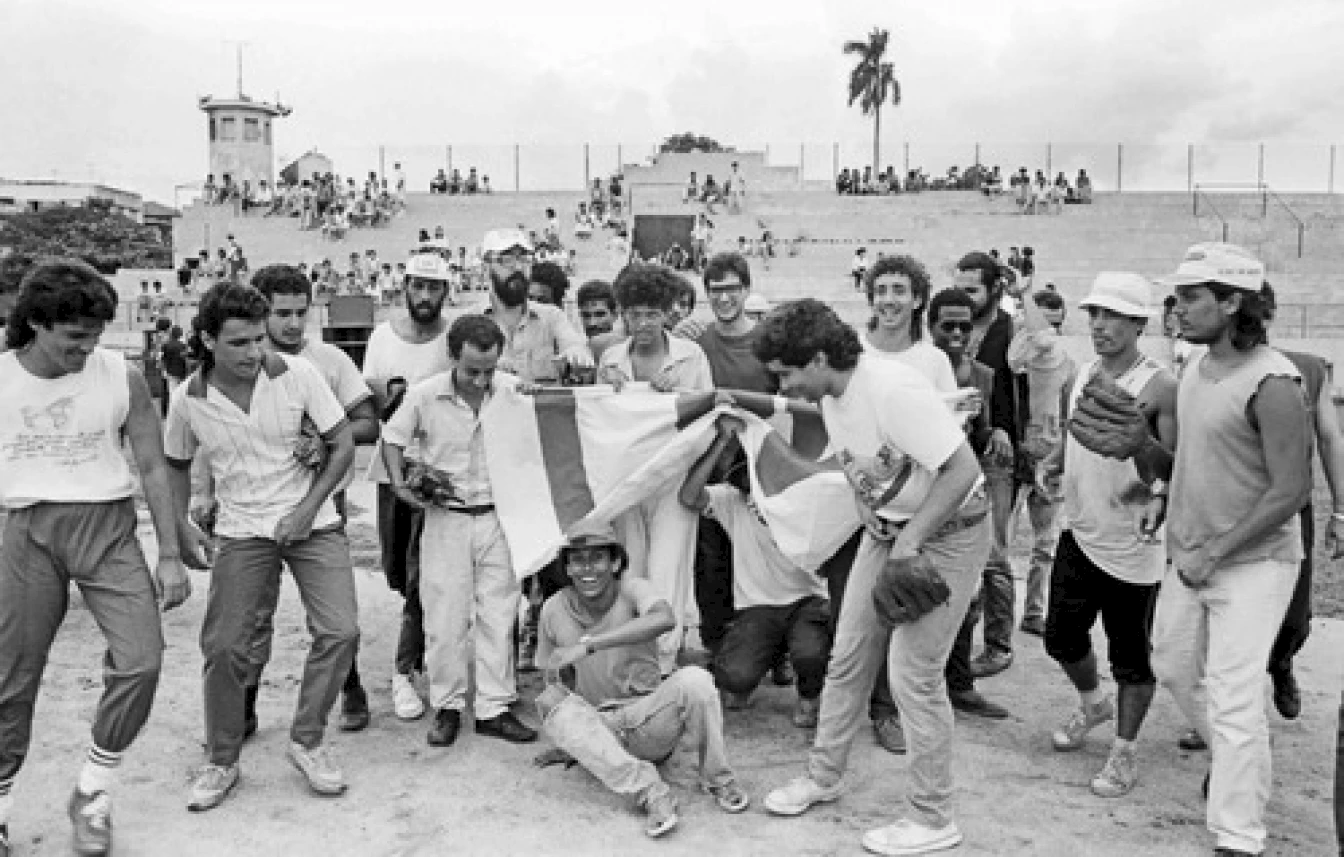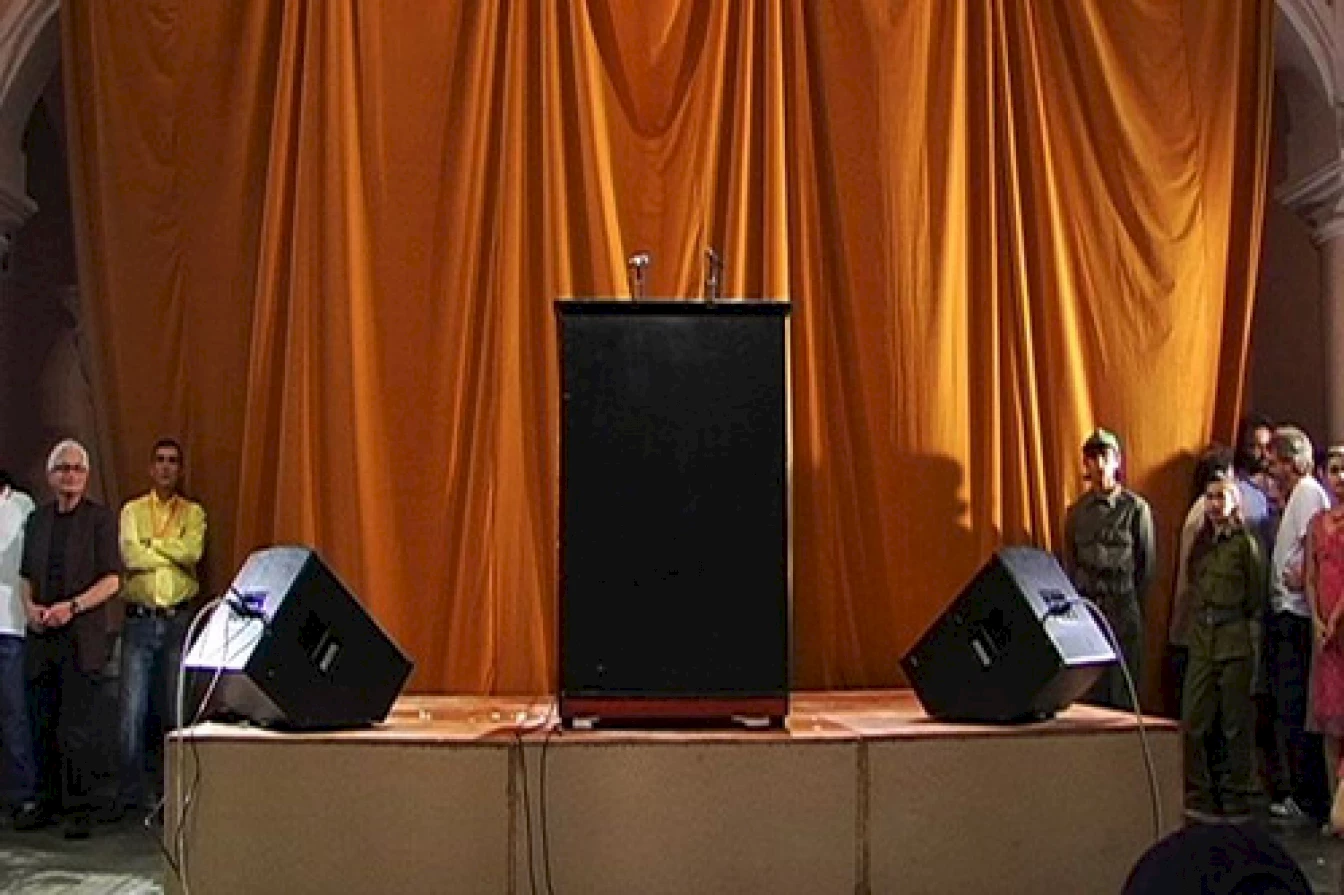Club Silencio and the Emptiness of the Square (regarding Tatlin's Whisper)

Ball Game, La Habana, September 24, 1989. Photo: Kattia García Fayat.
In a memorable scene from Mulholland Drive, the main characters walk into Club Silencio just as a magician on stage is warning against the illusory nature of representations. "No hay banda! There is no band", he says. The words "there is no band" were echoing in my ears recently as I tried to accompany Tatlin's Whisper #6, which Tania Bruguera began around 30 December and the Havana's Plaza de la Revolución.
"There is no band" could be a reference to the lack of broadband on the island; the limited Internet access that was certainly a barrier to spreading the call for participation in Havana. Nobody found out, nobody was listening. Nonetheless, in the absence of communication networks, word of mouth is a powerful weapon in Cuba. In 1989, word of mouth and a couple of posters were all it took to spread a call for participation in the baseball game that brought together a substantial number of artists, critics, curators, art student and other agents from Cuba's art world. A cursory comparison of these two gestures, both of which were calls for freedom of expression, inevitably leads to a pessimistic reading of the present situation: 'There is no band.'

Tania Bruguera, Tatlin’s Whisper #6 (Havana version), 2009.
To re-read the past in order to imagine another possible future. To look to actions such as La plástica joven se dedica al béisbol (Young Artists Take up Baseball) in order to open up the possibility of collective, political expression. This was the aim of a recent text1 about the Ball Game and about some works, exhibitions, and contexts in Cuba in 1989. But the Cuban art scene changed beyond recognition with the exile of almost an entire generation of artists and the consolidation of an art market that was undreamed of in the eighties. Even so, I think that revisiting the Ball Game in relation to the recent call for participation launched by Tania Bruguera can help us to interrogate the silence.
Although the Ball Game was organised in response to a series of episodes involving the censorship of exhibitions and projects, it would not have been possible without an arts community that shared interests, discussions and critical strategies, and that had by then recognised a shared malaise and was attempting a common stance. In this sense, the demand for freedom of expression implicit in the Ball Game is intensified in Tatlin's Whisper. But there's a big leap from Echeverría stadium to Plaza de la Revolución, just as there's a big leap from metaphor to literality, from oblique to direct criticism, from a curveball to a straight pitch, from ambiguity to frankness, from antagonism against the art institution to demands for political participation.
Tatlin's Whisper is an artistic action that addresses us as citizens first and foremost. After the announcement of the restoration of diplomatic relations between the United States and Cuba on 17 December last year, Tania Bruguera published a letter addressed to Obama, Raúl Castro and Pope Francis in which she, as a Cuban, demanded a space for participation in the decisions that affect our lives. She ended the letter with an invitation to participate in a symbolic updating of her performance Tatlin's Whisper #6, which had been held at the Wifredo Lam Centre during the 10th Havana Biennial in 2009. On that occasion, the work consisted of a podium, a microphone and one minute free of censorship for anybody who wanted to take the floor, as well as one white dove, two persons in military uniform, and 200 cameras. This time, it was reduced to one microphone that would remain open for 90 minutes in Plaza de la Revolución at 3 pm on 30 December. The artist's arrest along with almost seventy others before the scheduled performance reduced – or better still, expanded – the performance to an idea.
This time, political art is trying to interrupt the order of things. It is trying to disrupt designated roles that determine who can speak, when and where, which discourses can be heard and which become noise. The action did not take place, but even so its effects are certainly being felt. It seems to me that one of the most important of these is the way the work addresses each and every Cuban as political subjects. Not without some violence, Tatlin's Whisper forces us to get involved. "Power faces the opening up of a symbolic space in which every intervention is a form of participation",2 art critic Juan Antonio Molina wrote recently. Beyond its summoning of the State, I think that Tania Bruguera's wake-up call3 concerns us all. Nonetheless, it seems difficult to come together as an "us" in a fragmented social space in which suspicion prevails over trust and individual interests triumph over any idea of a common sphere. This neglect of the communal can be seen in Cuba's art scene, inside and outside the island.

Tania Bruguera, Tatlin’s Whisper #6 (Havana version), 2009.
On the afternoon of 30 December, the pro-government online channel Cuba Hoy filmed a video glorifying the Plaza de la Revolución going about its usual life, with its usual tourists having their photos taken against a backdrop of Jose Martí, Camilo Cienfuegos and Ché. "The only unusual thing" the presenter said with unbelievable cynicism, "is that some people and the foreign press actually believed the farce announced by Tania Bruguera and her team: can anybody see them? Because I can't." The square and the revolution as a political souvenir: that's we can see. But Tatlin's Whisper does not just call for the symbolic reappropriation of the square, the microphone, the podium, the place of enunciation; it calls for the becoming square, agora, democratic space of a place that is hyper-ideologised but empty of politics. A place where politics is choreographed but not practiced. Nobody saw Tania Bruguera's performance, but it took place nonetheless. Even in its impossibility, the gesture of the artist and the platform #yotambiénexijo (I also demand) made it possible to imagine another kind of square, to imagine a situation in which anybody could speak. Demanding myself to have a little hope, I go back to David Lynch's film and now they are saying: "No hay banda, and yet we hear a band."